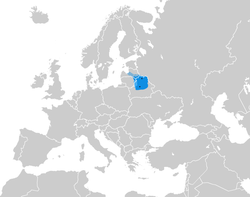
Back Полоцк кенәзлеге Bashkir Puoluocka Konėgākštīstė BAT-SMG Полацкае княства Byelorussian Полацкае княства BE-X-OLD Principat de Polotsk Catalan Polocké knížectví Czech Fyrstendømmet Polotsk Danish Fürstentum Polozk German Principado de Pólotsk Spanish Polotski vürstiriik Estonian
This article needs additional citations for verification. (June 2023) |
Principality of Polotsk Полотєскаѧ Княжество (Old East Slavic) | |||||||||
|---|---|---|---|---|---|---|---|---|---|
| 987–1504 | |||||||||
Banner of Polotesk under the Lithuanian domain.
Izyaslav's seal avers
| |||||||||
 The Principality of Polotsk on the map of Europe | |||||||||
| Status |
| ||||||||
| Capital | Polotesk | ||||||||
| Common languages | Old East Slavic | ||||||||
| Religion | Eastern Orthodoxy Slavic paganism | ||||||||
| Government | Monarchy | ||||||||
| Prince of Polotsk | |||||||||
• 1044–1101 | Vseslav | ||||||||
| Legislature | Veche | ||||||||
| History | |||||||||
• Established | 987 | ||||||||
• Total incorporation into the Grand Duchy of Lithuania | 1504 | ||||||||
| |||||||||
| Today part of | Belarus Latvia Russia | ||||||||
The Principality of Polotsk (Belarusian: По́лацкае кня́ства, romanized: Polackaje kniastva; Latin: Polocensis Ducatus), also known as the Duchy of Polotsk or Polotskian Rus',[1] was a medieval principality of the Early East Slavs.[2] The origin and date of state establishment is uncertain. Chronicles of Kievan Rus' mention Polotsk being conquered by Vladimir the Great,[3] and thereafter it became associated with Kievan Rus' and its ruling Rurik dynasty.
The principality was supposedly established around the town of Polotsk (now in Belarus) by the tribal union of Krivichs. In the second half of the 10th century, Polotsk was governed by its own dynasty; its first ruler mentioned in the chronicles was the semi-legendary Rogvolod (?–978), better known as the father of Rogneda. The principality was heavily involved in several succession crises of the 11th–12th centuries and a war with the Land of Novgorod. By the 13th century, it was integrated into the Grand Duchy of Lithuania.
At the time of its greatest extent, the principality stretched over large parts of present-day northern and central Belarus and a smaller part of today's southeastern Latvia, including (besides Polotsk itself) the following towns: Vitebsk, Drutsk, Minsk, Izjaslaw (now Zaslawye), Lahoysk, Barysaw, Brachyslaw (now Braslaw), Kukeinos (now Koknese) and others.
- ^ Linda Gordon (1983): Cossack Rebellions: Social Turmoil in the Sixteenth Century Ukraine (p. 241)
- ^ Fennell, J. (2014). The Crisis of Medieval Russia 1200–1304. Longman History of Russia. Taylor & Francis. p. 17. ISBN 978-1-317-87314-3. Retrieved 14 September 2018.
- ^ Feldbrugge, Ferdinand J. M. (20 October 2017). A History of Russian Law: From Ancient Times to the Council Code (Ulozhenie) of Tsar Aleksei Mikhailovich of 1649. BRILL. p. 27. ISBN 9789004352148.
© MMXXIII Rich X Search. We shall prevail. All rights reserved. Rich X Search

